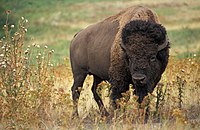
Photo from wikipedia
Island ecosystems provide models to assess the impacts of isolation on population persistence. However, most studies of persistence have focused on a single species, without comparisons to other organisms they… Click to show full abstract
Island ecosystems provide models to assess the impacts of isolation on population persistence. However, most studies of persistence have focused on a single species, without comparisons to other organisms they interact with in the ecosystem. The simple predator-prey system of moose and gray wolves on Isle Royale provides allows a direct contrast of genetic variation in a prey species with their natural predator. Wolves on Isle Royale exhibited signs of severe inbreeding depression, which nearly drove the population to extinction in 2019. In the relative absence of wolves, the moose population has thrived and exhibits no obvious signs of inbreeding depression despite being isolated for ∼120 years and having low genetic diversity. Here, we examine the genomic underpinnings of population persistence in the Isle Royale moose population. We document high levels of inbreeding in the population, roughly as high as the wolf population at the time of its decline. However, inbreeding in the moose population manifests in the form of intermediate-length runs of homozygosity indicative of gradual inbreeding, contrasting with the severe recent inbreeding observed in the wolf population. Using simulations, we demonstrate that this more gradual inbreeding in the moose population has resulted in an estimated 50% purging of the inbreeding load, helping to explain the continued persistence of the population. However, we also document notable increases in genetic load, which could eventually threaten population viability over the long term. Finally, we document low diversity in mainland North American moose populations due to a severe founder event occurring near the end of the Holocene. Overall, our results demonstrate a complex relationship between inbreeding, genetic diversity, and population viability that highlights the importance of maintaining isolated populations at moderate size to avert extinction from genetic factors. Significance statement Isolated wildlife populations face a high risk of extinction due in part to the deleterious consequences of inbreeding. Whether purifying natural selection can overcome these negative impacts by “purging” harmful recessive mutations is a topic of active debate. We characterized the extent of purging in an isolated moose population. Our results demonstrate signatures of gradual inbreeding in the population, ideal circumstances to facilitate purging. Using simulations, we demonstrate substantial potential for purging in the population, though we also show that fitness is reduced by small population size and inbreeding. Our findings provide insight into the mechanisms enabling persistence in isolated populations, with implications for conserving the growing number of isolated populations worldwide.
Journal Title: Molecular Biology and Evolution
Year Published: 2022
Link to full text (if available)
Share on Social Media: Sign Up to like & get
recommendations!